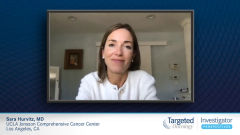
Treatment Options For Advanced ER+ Breast Cancer
Sara Hurvitz, MD, discusses the therapeutic landscape for HR+ advanced breast cancer and considerations for treatment selection.
Sara Hurvitz, MD: Focusing on the available treatment options for advanced hormone receptor-positive breast cancer, we have a variety of agents that target the hormone pathway. First, we have tamoxifen or estrogen receptor modulators which block the estrogen receptor in breast cancer cells. Tamoxifen is a pill that’s been around for a long time, we know a lot about it and we do know that it is effective for a time for patients with hormone receptor-positive advanced breast cancer.
More recently, a class of drugs known as aromatase inhibitors, including anastrozole, letrozole, and exemestane have been developed. These drugs block the production of estrogen from peripheral sources or nonovarian sources. They are pills like tamoxifen and can be used in women who do not have functioning ovaries, for example, postmenopausal women or women who are on ovarian suppression agents such as leuprolide or goserelin. Aromatase inhibitors are more effective than tamoxifen at controlling disease that’s hormone receptor-positive stage IV breast cancer.
And then more recently a class of drugs known as estrogen receptor down regulators have been developed. The first of these to be clinical validated and made available for stage IV breast cancer is fulvestrant, initially developed the dose of 250 mg once monthly. It looked like it had similar efficacy compared to aromatase inhibitors in later-line advanced disease. However, when dosing trials were done demonstrating better efficacy with the 500-mg dosing regimen and a loading dose given in the middle of month 1, this drug showed superior efficacy when compared to an aromatase inhibitor for hormone receptor-positive advanced breast cancer.
In 2012, we had the development of a class of drugs called mammalian target of rapamycin inhibitors or mTOR inhibitors. Everolimus was an mTOR inhibitor evaluated, a pill that is given with endocrine therapy and blocks PI3 kinase AKT mTOR pathway. When added to endocrine therapy in patients whose disease had progressed on an aromatase inhibitor, this drug was shown to lengthen the progression-free survival and is available to women with advanced hormone receptor-positive breast cancer.
In 2015, we saw promising data supporting the use of a class of agents known as cyclin-dependent kinase 4/6 inhibitors. The first of these was palbociclib, receiving accelerated approval in 2015 in combination with an aromatase inhibitor for the first-line treatment of patients with metastatic hormone receptor-positive breast cancer. There are now 3 agents, palbociclib, ribociclib, and abemaciclib, that have shown consistent dramatic significant improvements in progression-free survival and as well as improvements in the objective response rate when added to endocrine therapy compared with endocrine therapy alone. These agents have become the standard of care in the frontline treatment of breast cancer.
Sometimes there are challenges with any therapy that we give, and you must consider that the adverse effect profile of the new agent. Palbociclib and ribociclib can cause neutropenia. Patients are generally not aware of it and it’s generally not dangerous, but it does require that those 2 drugs be given 3 weeks on and 1 week off. Abemaciclib has some neutropenia associated with it but less and it can be given continuously and dosed BID. However, it has more GI [gastrointestinal] adverse effects associated with it, mainly diarrhea. Other adverse effect profile differences and dosing differences can help us sort out which patients would benefit from which therapy. But it is important to note that the progression-free survival associated with each of these agents is somewhat similar in the frontline setting.
Transcript edited for clarity.









































